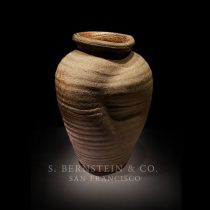“Fishing in the Jade Pond” Article by Sam Bernstein
Published in Orientations, September 1995, page 110
One of the precise indicators of an upwardly mobile art market is an increase in spurious works of art. Fakers, above all, are denizens of the market place. It may truthfully be said that fakes delineate the evolution of taste and fads in collecting with surprising precision. Their creation is a response to demand which is an ever-changing reflection of human desires. Further, fakes provide an understanding of the people who make them and those for whom the fakes are made.
Chinese jade is at the present time experiencing an increase in demand and the attention of both beginning collectors and connoisseurs alike. Following each wave of archaeological discovery, spurious copies have entered the market place. A subtle difference however, has emerged which separates the present from past trends in fakery. An increase in technological sophistication has been brought to bear on the efforts of the fakers. Scholars in other disciplines, such as Chinese metalwork and porcelain, have bemoaned the fact that fakers are often one step ahead of the academics and dealers who catch on to them. It is a dubious tribute to the ingenuity of the human mind that enables the faker to simulate both the obvious and more subtle tell-tale signs of authenticity.
Sadly, each society and generation fakes the art it covets most. Roman copies of Greek sculpture kept generations of sculptors basically producing both imitations and copies. In our own lifetime, the works of Picasso, Degas, Renoir, Van Gogh, Manet, and Dali have been copied and imitated. Indeed, many paintings which Lord Joseph Duveen sold to American millionaires early in this century were copied so that the seller would have a replica to hang on the mantle. Fakers move quickly to take advantage of the high prices produced by a new collecting trend before their activities undermine the market altogether. Witness the strong auction record prices of white eighteenth century jades. This writer has begun to encounter an increasing number of spurious copies executed with amazing sophistication.
Consider for a moment what constitutes a fake. Aside from a question of interest on the part of the faker, there are copies, imitations, and replicas. Copies are executed based on an original work of art. Many fake jades in the market place today are copied from published examples of excavated artifacts. The copy at first appears enticing, but under close scrutiny is less than convincing. Once the spell is broken, the ugly and unsatisfying truth emerges. Imitations are simulations which mimic the attributes of the original. Again, the imitation is less than satisfying if viewed in the bright light of day. Replicas of art objects attempt with varying degrees of success to reproduce a work of art. The replica is a place holder, not meant to imitate or copy.
It is important to understand that a jade piece emulating a Han (206 BC-AD 220) jade done in the Song period (960-1279) is not the same thing as a fake. In Chinese art, the dominant mode of activity is a desire to maintain and rework traditional forms and subjects. Nostalgia for the past and emulation of its achievements is desirable. Emulation is good since it allows each period to interpret and modify traditional forms. Misrepresentation of an imitation as “the real thing,” however, is fakery.
Unfortunately, when a fake is discovered, it severs a direct link with the hand that made it. Even though the work remains the same, the aesthetic response to it is profoundly changed. If we are smart, we will learn from the experience and avoid making the same mistake twice. From experience, most buyers know that the price paid for a seeming bargain cannot be for the real thing. They are buying an illusion and delude themselves. This is the faker’s main weapon in perpetrating his fraud on the collector. If the work is too good to be true, then it usually is.
The buyer of the fake keeps the faker in business. The real loss resulting from the discovery of a fake is not only monetary. For the person cheated, it loosens the hold on our perception and understanding of the past. One of the strongest tools a collector possesses for uncovering fakes is the most obvious. This is simply the fact that a faker, whether he copies, imitates, or replicates, can never assume the mind-set of the artist of an original work and period. Fakers add flourishes and details without really understanding the symbolism and purpose behind the original concept. Familiarity with jades of a particular period enables the collector to understand why an artist used certain motifs as well as the stylistic and physical approach to the jade.
Finally, our concept of authenticity depends on the relationship between the work of art itself and the period to which it is attributed. Determination of authenticity requires a methodology counting on a consistency of both stylistic and physical analysis of the object. Looking at the work of art with a critical eye is the number one defense for detecting fakery. It is misleading to think that scientific advances and scholarly expertise alone can solve all problems. However, an open, questioning mind can eliminate many of the more obvious pitfalls. Ask yourself, is this work of art convincing? Is it stylistically and physically consistent? What is the artist trying to convey? Does the object exhibit logicality? Does it make sense? Be cautious, selective, and assume the work of art is guilty until proven correct. The thrill and passion of collecting outweighs its negative side. Never for a moment let the faker deny you the pleasure of collecting. We are all seekers of truth about works of art and the direct link with those who made them.
Sam Bernstein is director of S. Bernstein & Co., a gallery specializing in Chinese jade works of art in San Francisco
© 1995 S. Bernstein & Co.

